All proper flexagons, no matter what the cycle, have certain very
important characteristics which may now be used to define the family of
proper flexagons. The first important characteristic is found in the
hinging order of all proper flexagons with complete ![]() flex cycles. Take,
for example, a complete single cycle flexagon. The leaves of this flexagon
are always hinged to one another in the hinge order 1 2 3 ...
flex cycles. Take,
for example, a complete single cycle flexagon. The leaves of this flexagon
are always hinged to one another in the hinge order 1 2 3 ...![]() 0.
This sequence is called the hinge sequence. This particular hinge sequence
in which the numbers run consecutively from 1 to 0 mod.
0.
This sequence is called the hinge sequence. This particular hinge sequence
in which the numbers run consecutively from 1 to 0 mod. ![]() is characteristic
of single cycle proper flexagons. The constant order is the other
important characteristic. In single cycle
is characteristic
of single cycle proper flexagons. The constant order is the other
important characteristic. In single cycle ![]() flexagons it is always
consecutive: 1 2 3 ...
flexagons it is always
consecutive: 1 2 3 ...![]() . If more cycles are added to the single
cycle proper flexagon, some single leaves of the original flexagon become
subpats. The subpats will contain all the sides of the new cycle, and
since the new cycles are proper, the pat structures and hinge sequences
of the subpats must be consecutive. It is true that the constant order
and the hinge sequences of proper flexagons with more than one cycle are
not consecutive, but the subpats will always be arranged consecutively
from top to bottom, and the hinging of those subpats will always be
consecutive.
. If more cycles are added to the single
cycle proper flexagon, some single leaves of the original flexagon become
subpats. The subpats will contain all the sides of the new cycle, and
since the new cycles are proper, the pat structures and hinge sequences
of the subpats must be consecutive. It is true that the constant order
and the hinge sequences of proper flexagons with more than one cycle are
not consecutive, but the subpats will always be arranged consecutively
from top to bottom, and the hinging of those subpats will always be
consecutive.
It is important to notice that a ![]() flexagon with
flexagon with ![]() greater than
3 has more than one thumbhole, a thumbhole occurring when there is a positive
hinge difference between two successive leaves in the pat structure. If we
look at the pat structure of the ``simple'' proper pat, that is the pat from
a single cycle flexagon (as opposed to a compound pat from a multi-cycle
flexagon), we find that it may be either 1 or 1 2 3 ...
greater than
3 has more than one thumbhole, a thumbhole occurring when there is a positive
hinge difference between two successive leaves in the pat structure. If we
look at the pat structure of the ``simple'' proper pat, that is the pat from
a single cycle flexagon (as opposed to a compound pat from a multi-cycle
flexagon), we find that it may be either 1 or 1 2 3 ...![]() where
where ![]() is
the degree of the pat.
The first pat has no thumbholes but in the second pat there will be
thumbholes between leaves 1 and 2, 2 and 3, ...
is
the degree of the pat.
The first pat has no thumbholes but in the second pat there will be
thumbholes between leaves 1 and 2, 2 and 3, ...![]() and
and ![]() , or
, or ![]() thumbholes per pat. If we designate these thumbholes from top to bottom
1 2 3 ...
thumbholes per pat. If we designate these thumbholes from top to bottom
1 2 3 ...![]() and then observe their operation, it will be seen that
thumbhole 1 has a number 1 hinge associated with it and thus is used in a
and then observe their operation, it will be seen that
thumbhole 1 has a number 1 hinge associated with it and thus is used in a
![]() flex, while each succeeding thumbhole is used for a correspondingly
higher order flex. After a flex and rotation, the thumbholes should
be renumbered, but it should be observed that what was originally a
number 1 thumbhole has now opened out to display a new side while the
old number 2 thumbhole has been rotated in such a way that its hinge
is in a number 1 position. The thumbhole at the very bottom has been
generated by folding together the side which was on the back of the
flexagon before flexing. This last thumbhole has a hinge in a
flex, while each succeeding thumbhole is used for a correspondingly
higher order flex. After a flex and rotation, the thumbholes should
be renumbered, but it should be observed that what was originally a
number 1 thumbhole has now opened out to display a new side while the
old number 2 thumbhole has been rotated in such a way that its hinge
is in a number 1 position. The thumbhole at the very bottom has been
generated by folding together the side which was on the back of the
flexagon before flexing. This last thumbhole has a hinge in a ![]() position and may be used for flexing backwards. This discovery, that
a given pat has
position and may be used for flexing backwards. This discovery, that
a given pat has ![]() thumbholes, makes it necessary for us to revise
our definition of a pat. A pat, therefore, may be defined (in a circular
way) as a series of subpats, each of which is a pat in itself; alternate
subpats being inverted. The total number of subpats in a given unit is
equal to the cycle. In proper flexagons, there are
thumbholes, makes it necessary for us to revise
our definition of a pat. A pat, therefore, may be defined (in a circular
way) as a series of subpats, each of which is a pat in itself; alternate
subpats being inverted. The total number of subpats in a given unit is
equal to the cycle. In proper flexagons, there are ![]() subpats in
one pat of the unfolded flexagon and one subpat in the remaining pat.
subpats in
one pat of the unfolded flexagon and one subpat in the remaining pat.
Each single leaf of a simple proper flexagon unit is associated with two hinges and each hinge with two leaves. We may show this by writing down the constant order and indicating the hinges between two leaves as follows:
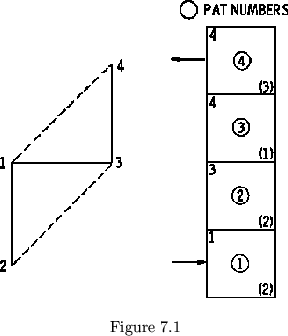
This is the constant order and hinge structure for a one-cycle proper tetraflexagon. But what would happen if we were to try to write the unit and hinge structures for a tetraflexagon with the map as in figure 7.1. Its constant order is 1 2; 4 3 while its hinge sequence is 1 3 1 0. Combined this would make:
This is a rather inconvenient method of notation, so instead, we will only associate one hinge with one leaf. Arbitrarily we will identify the first leaf with the first hinge of the hinge sequence. The leaf with pat number 2 will be associated with the second hinge, etc. The example above would then become:
Previously, we assigned hinge positions
around a polygon in a certain direction of ascending values.
This direction was clockwise and may be indicated around the face of a
polygon by vectors drawn in the same direction along the edges of each
side. A certain side will be designated as the zero position and it will
be agreed that the side toward which the zero-side vector points to will
be the ``1'' position. Then we may systematically follow the vectors and
number each position with the number of vectors which are between it and
the zero position (see figure 7.2a). These vectors may be drawn on both
sides of all the leaves in the unit
in such a way that when the unit is
folded together, the vectors all
point in the same direction. This
``orientation'' of the polygons of a
unit will give us a frame of reference
when the flexagon is unfolded. Before
unfolding the flexagon, it would be well to note the relationship
existing between the two hinges associated with a given leaf. If the
hinge associated with the previous leaf (with respect to increasing
pat numbering) was in an ![]() position and the one we are concerned with
is in a
position and the one we are concerned with
is in a ![]() position, the position this
position, the position this ![]() hinge holds with
respect to the
hinge holds with
respect to the ![]() position hinge is
position hinge is ![]() , the difference between the two
hinges. This difference between two hinges attached to the same leaf
is the ``hinge difference'' across that leaf. The advantage of the hinge
difference is that it is independent of the arbitrarily assigned zero
point for the hinge sequence. The hinge sequence for a one cycle proper
flexagon is
, the difference between the two
hinges. This difference between two hinges attached to the same leaf
is the ``hinge difference'' across that leaf. The advantage of the hinge
difference is that it is independent of the arbitrarily assigned zero
point for the hinge sequence. The hinge sequence for a one cycle proper
flexagon is
![]() ,
,
![]() . The hinge difference across
the first leaf is
. The hinge difference across
the first leaf is ![]() , that across the second
, that across the second ![]() , etc.
Since the hinge sequence is consecutive the hinge differences will all
be one. These hinge differences nay be written in the following manner:
, etc.
Since the hinge sequence is consecutive the hinge differences will all
be one. These hinge differences nay be written in the following manner:
| Hinge difference | 1 | 1 | 1 | 1 | 1 | |
| Hinge sequence | 1 | 2 | 3 | 4 | ... | 0 |
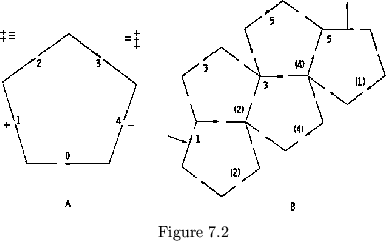
The first ``1'' is the
difference between an understood 0 hinge and the hinge in position one.
The last ``I'' is the difference between ![]() and (0 mod.
and (0 mod. ![]() ) or just
) or just ![]() .
If we now open up the flexagon, we see this constant difference of 1
quite plainly. A given hinge is always one side removed from another
hinge attached to the same leaf (see figure 7.2b). One will notice,
however, that the direction is alternately left and right. This is because
alternate leaves in the pat were inverted, as a result of the folding
process. The vectors help keep track of things, for they point in a
consistent manner around the unit polygons of the folded flexagon. The
hinge of a certain leaf in the unfolded flexagon will always bear the
same relationship to the vectors of that leaf as the hinge of any other
leaf. That is, if we decide to travel along the plan in a given direction,
the vectors we cross in going from one leaf to another will always point
consistently toward or away from the next hinge. Whichever way they do
point, they can always be made to point the other way by starting at the
other end of the plan.
.
If we now open up the flexagon, we see this constant difference of 1
quite plainly. A given hinge is always one side removed from another
hinge attached to the same leaf (see figure 7.2b). One will notice,
however, that the direction is alternately left and right. This is because
alternate leaves in the pat were inverted, as a result of the folding
process. The vectors help keep track of things, for they point in a
consistent manner around the unit polygons of the folded flexagon. The
hinge of a certain leaf in the unfolded flexagon will always bear the
same relationship to the vectors of that leaf as the hinge of any other
leaf. That is, if we decide to travel along the plan in a given direction,
the vectors we cross in going from one leaf to another will always point
consistently toward or away from the next hinge. Whichever way they do
point, they can always be made to point the other way by starting at the
other end of the plan.
It is convenient for certain purposes which will become apparent
to call the direction toward which the vector points + and the direction
away from it -. Thus a ![]() hinge is +2 or
hinge is +2 or ![]() while a
while a ![]() hinge
is - and a
hinge
is - and a ![]() hinge
is (
hinge
is (![]() ) (see figure 7.2a). The sign sequence for a proper flexagon
of one cycle, then is +++...or
) (see figure 7.2a). The sign sequence for a proper flexagon
of one cycle, then is +++...or ![]() .... Here we see that + and
- may be exchanged for one another just as in the triflexagons.
.... Here we see that + and
- may be exchanged for one another just as in the triflexagons.
The Polygon System
There are ![]() possible hinges for a leaf with G
sides. 7.1With proper flexagon leaves, however, there are only two possibilities
if the flexagon is ``complete'', i. e. if it contains no incomplete cycles.
To prove this, let us look at a proper complete single cycle
possible hinges for a leaf with G
sides. 7.1With proper flexagon leaves, however, there are only two possibilities
if the flexagon is ``complete'', i. e. if it contains no incomplete cycles.
To prove this, let us look at a proper complete single cycle ![]() flexagon.
This flexagon, as we have seen has two possible sign sequences, +++ ...++
or
flexagon.
This flexagon, as we have seen has two possible sign sequences, +++ ...++
or ![]() . Now, if we add another cycle to this flexagon, we will be
making a subpat out of what was previously a single leaf. If we added
the new cycle between sides
. Now, if we add another cycle to this flexagon, we will be
making a subpat out of what was previously a single leaf. If we added
the new cycle between sides ![]() and
and ![]() , the single leaf we must slit
will have
, the single leaf we must slit
will have ![]() on one side and
on one side and ![]() on the other. The
on the other. The ![]() possible
places for attaching new cycles on the map correspond to the
possible
places for attaching new cycles on the map correspond to the ![]() single
leaves in a unit of a one cycle
single
leaves in a unit of a one cycle ![]() flexagon. If we do build subpats
out of one or more of the single leaves of a single cycle
flexagon. If we do build subpats
out of one or more of the single leaves of a single cycle ![]() flexagon, each
subpat must have the same characteristics as the large pat in order for
the flexagon to remain proper. Thus we know that the hinge difference
between successive leaves in the subpat must consistently be either + or
flexagon, each
subpat must have the same characteristics as the large pat in order for
the flexagon to remain proper. Thus we know that the hinge difference
between successive leaves in the subpat must consistently be either + or
![]() and that the pat structure must be consecutive (these are the two
requirements for a proper pat). We also know that the hinge difference
across the whole subpat must be
and that the pat structure must be consecutive (these are the two
requirements for a proper pat). We also know that the hinge difference
across the whole subpat must be ![]() when viewed from the top, with the
vectors pointing clockwise since the leaf from which the subpat was
generated had a +1 hinge difference. Since there will be
when viewed from the top, with the
vectors pointing clockwise since the leaf from which the subpat was
generated had a +1 hinge difference. Since there will be ![]() sides
and hence
sides
and hence ![]() leaves added to the one leaf already present (as a
former member of the large pat) there will be a total of
leaves added to the one leaf already present (as a
former member of the large pat) there will be a total of ![]() leaves
in the subpat. If the hinge differences must be consistently either
+1 or
leaves
in the subpat. If the hinge differences must be consistently either
+1 or ![]() for each of the leaves, and if there are
for each of the leaves, and if there are ![]() leaves, which
must have a total hinge difference of +1, the individual hinge difference
must be
leaves, which
must have a total hinge difference of +1, the individual hinge difference
must be ![]() , since
, since
![]() . If the individual hinge
difference were +1, the total difference would be
. If the individual hinge
difference were +1, the total difference would be ![]() mod
mod
![]() . Therefore, the hinge differences between the
leaves of the subpat are negative with respect to those of the large
pat. Similarly, if another subpat were to replace a leaf of this subpat,
the individual hinge differences would be +1, since the hinge difference
across a leaf of the first subpat is
. Therefore, the hinge differences between the
leaves of the subpat are negative with respect to those of the large
pat. Similarly, if another subpat were to replace a leaf of this subpat,
the individual hinge differences would be +1, since the hinge difference
across a leaf of the first subpat is ![]() . The pat structure of any
subpat will be inverted with respect to the next larger pat or subpat of
which it is a member, just as was so with triflexagons. Therefore,
when the leaves of a large pat are numbered
. The pat structure of any
subpat will be inverted with respect to the next larger pat or subpat of
which it is a member, just as was so with triflexagons. Therefore,
when the leaves of a large pat are numbered
![]() in ascending order from top to bottom, the subpats will be numbered
in ascending order from bottom to top. Now, when such a compound pat
is unwound, the progression of the number sequence from smaller to
larger numbers in that portion of the plan which corresponds to the
subpat will be just opposite the progression in that part of the plan
in which the subpats were single leaves. This means that if we have
a given complete one cycle
in ascending order from top to bottom, the subpats will be numbered
in ascending order from bottom to top. Now, when such a compound pat
is unwound, the progression of the number sequence from smaller to
larger numbers in that portion of the plan which corresponds to the
subpat will be just opposite the progression in that part of the plan
in which the subpats were single leaves. This means that if we have
a given complete one cycle ![]() flexagon whose number and sign sequences
are:
flexagon whose number and sign sequences
are:
| + | + | + | + | + | + | + | + | ||
| (1) | 3 | (3) | 5 | ... | (a) | a+2 | ... | (G-1) | 1 |
| 2 | (2) | 4 | (4) | ... | a+1 | (a+1) | ... | G | (G) |
| + | + | + | + | - | - | - | - | + | + | + | + | ||||
| (1) | 3 | (3) | ... | a | (a+G-2) | a+G-2 | ... | a+2 | (a) | a+G | (a+G) | a+G+2 | ... | (2G-3) | 1 |
| 2 | (2) | 4 | ... | (a-1) | a+G-l | (a+G-3) | ... | (a+1) | a+l | (a+G-1) | a+G+1 | (a+G+1) | ... | 2G-2 | (2G-2) |
| + | + | + | + | - | - | - | - | - | - | - | + | + | + |
| (1) | 3 | (3) | 5 | (11) | 11 | (9) | 9 | (7) | 7 | (5) | 13 | (13) | 1 |
| 2 | (2) | 4 | (4) | 12 | (10) | 10 | (8) | 8 | (6) | 6 | (12) | l4 | (l4) |
| (a-1) | (a+G-2) | (a+l) | (a) | (a+G-l) | (2G-2) |
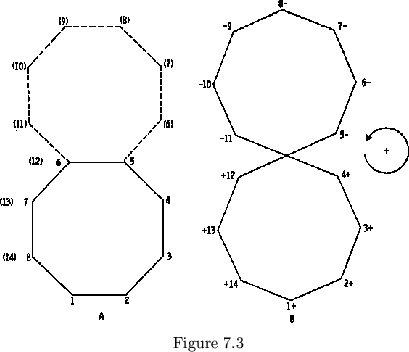
If we want to add another subpat to one of the leaves of the new subpat, its numbers would be reversed with respect to the already reversed numbers of the first subpat: they would increase from left to right and the signs would be +.
To figure out the plan by this method would be a long and tedious job, but it happens that one can use a shortcut device which is similar to the Tukey triangle system in the triflexagons. This shortcut makes use of a ``polygon system'' which is simply a generalization of the triangle system. The network is arrived at by drawing lines between the midpoints of the polygons making up the map and assigning numbers to the vertices thus formed (see figure 7.4a). The polygon system is followed in the same manner as the Tukey triangle system: The numbers of the vertices are written down in order to give the basic number sequence. The number sequence for the plan is arrived at by writing down the numbers of the basic number sequence alternately above and below a line and then adding 1 to each, placing the result on the other side of the line as shown:
| + | + | + | + | + | + | - | - | - | + | + | - |
| 1 | 3 | 3 | 11 | 11 | 1 | 7 | 7 | 5 | 9 | 9 | 55 |
| 2 | 2 | 4 | 10 | 12 | 12 | 8 | 6 | 6 | 8 | 10 | 4 |
A certain positive direction in the polygon system may be assigned. When
a bend in the polygon system is made in that direction, the vertex at the
bend is labeled +; when the bend is in the opposite direction, the vertex
is -. Using this method, the sign and number sequences of any proper
complete ![]() flexagon can be found, and its plan constructed in a manner
similar to triflexagon plans: A system of oriented polygons is used.
Choose one such polygon, and choose the side through which to enter that
polygon. A + of the sign sequence means that the polygon must be left
through the side toward which the vector of the side entered points;
a - means the polygon must be left through the side away from the vector.
The process is repeated using the next sign in the sign sequence, until
the desired number of units have been manufactured (see figure 7.4b).
flexagon can be found, and its plan constructed in a manner
similar to triflexagon plans: A system of oriented polygons is used.
Choose one such polygon, and choose the side through which to enter that
polygon. A + of the sign sequence means that the polygon must be left
through the side toward which the vector of the side entered points;
a - means the polygon must be left through the side away from the vector.
The process is repeated using the next sign in the sign sequence, until
the desired number of units have been manufactured (see figure 7.4b).
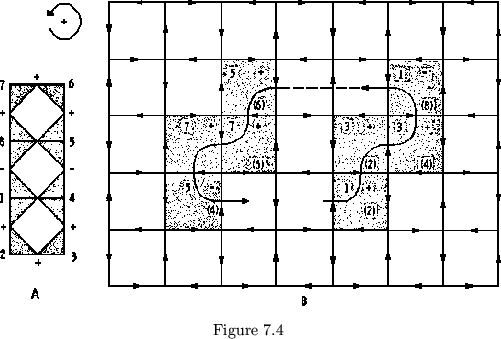
A Tuckerman tree may be drawn to represent the map polygons,
and the polygon system may be drawn about it; The Tuckerman tree for
a given ![]() flexagon is not unique however, since a
flexagon is not unique however, since a ![]() flexagon can be
built with the same tree. The polygon system will work for proper complete
flexagons only, because it allows no more than two possible
choices for hinging, where-as a leaf of class
flexagon can be
built with the same tree. The polygon system will work for proper complete
flexagons only, because it allows no more than two possible
choices for hinging, where-as a leaf of class ![]() offers
offers ![]() possibilities.
Only in the case of triflexagons will the polygon system account
for all possibilities.
possibilities.
Only in the case of triflexagons will the polygon system account
for all possibilities.
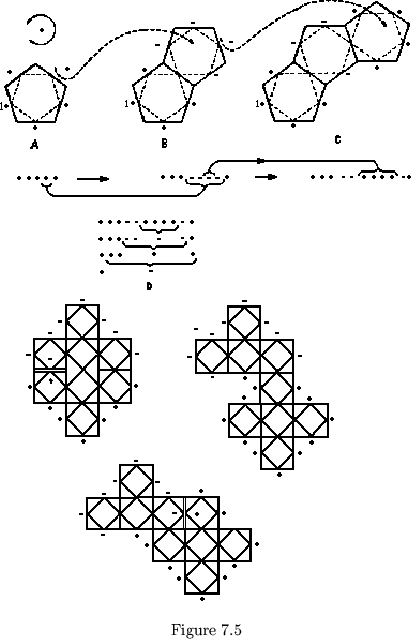
A complete proper ![]() flexagon of one cycle has a sign sequence
composed entirely of + signs. If we add another cycle to this single
cycle, one of the + signs is withdrawn from the sign sequence and in
its place are put
flexagon of one cycle has a sign sequence
composed entirely of + signs. If we add another cycle to this single
cycle, one of the + signs is withdrawn from the sign sequence and in
its place are put ![]() minus signs (see figure 7.5b). If we wish to
continue, we may withdraw one of the minus signs and substitute
minus signs (see figure 7.5b). If we wish to
continue, we may withdraw one of the minus signs and substitute ![]() plus signs (see figure 7.5c). Similarly, we may systematically reduce
a flexagon with a number of cycles to one with a single cycle by
exchanging
plus signs (see figure 7.5c). Similarly, we may systematically reduce
a flexagon with a number of cycles to one with a single cycle by
exchanging ![]() adjacent signs of one kind for one of the opposite signs
(see figure 7.5d). A given proper cycle always reduces by this method
to
adjacent signs of one kind for one of the opposite signs
(see figure 7.5d). A given proper cycle always reduces by this method
to ![]() . Since the + in
the
. Since the + in
the ![]() represents a
represents a ![]() hinge and - represents
hinge and - represents ![]() hinge,
we can add the two hinges:
hinge,
we can add the two hinges:
![]() . Thus we have
established that the sum of the signs of a given sign sequence must be
congruent with
. Thus we have
established that the sum of the signs of a given sign sequence must be
congruent with
![]() . In triflexagons,
. In triflexagons, ![]() so the summation of the
sign sequence equals
so the summation of the
sign sequence equals
![]() , which has already been shown. If a given
sign sequence is congruent to
, which has already been shown. If a given
sign sequence is congruent to
![]() , we may find out how many
different flexagons can be made from it by reducing groups of
, we may find out how many
different flexagons can be made from it by reducing groups of ![]() of a
given sign to one of the opposite sign.
of a
given sign to one of the opposite sign.
Example:
The tetraflexagon sign sequence
![]() may
be reduced to
may
be reduced to ![]() in a number of different ways:
in a number of different ways:
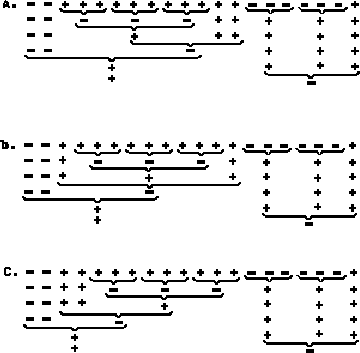
These are just three possibilities. There are more.